- two nights in Quito (capital of Ecuador); our thoughts on Quito are discussed in this post.
- two nights in Puerto Baquerizo Moreno (San Cristóbal Island)
- two nights in Puerto Villamil (Isabela Island)
- two nights in Puerto Ayora (Santa Cruz Island).
- two nights in Quito
Back to the plants. By the nature of the tour, the plants shown here are easily viewed in the areas to which most tourists to the islands have ready access. Out of respect for the environment we didn’t go off any marked trails or wander too far from the eyes of our guides. Many plants, especially introduced ones, can be seen on more that one island. Others, in particular endemics, are found only on one island. In another post we discussed references we used to help make our identifications. Furthermore, we solicited input from the Charles Darwin Foundation on some plants we could not identify and they were very helpful. Consider a donation to them continue their work in the islands.
References used below:
- [cdf] = Charles Darwin Foundation Galápagos Species Checklist
[Bungartz, F., Herrera, H.W., Jaramillo, P., Tirado, N., Jiménez-Uzcátegui, G., Ruiz, D., Guézou, A. & Ziemmeck, F. (eds.) (2009). Charles Darwin Foundation Galapagos Species Checklist - Lista de Especies de Galápagos de la Fundación Charles Darwin. Charles Darwin Foundation / Fundación Charles Darwin, Puerto Ayora, Galapagos: .] - [CRC] = CRC World Dictionary of Plant Names
- [dg] = Dave’s Garden, Botanary
- [ckm] = Flowering Plants of the Galápagos by Conley K. McMullen, see this post for more information. This is a good reference for common names.
- [ref] = general reference
| Common Name | Matazarno |
| Local Name | Matazarno |
| Binomial Name | Piscidia carthagenensis |
| Family | Fabaceae |
| Notes | Generic name from the Latin piscis for “fish” and caedo “to kill, destroy or cut down, slaughter” referring to the roots that yield a fish poison. [CRC] |
| Status | Native [cdf] |
| Location | Photo 1: Puerto Baquerizo Moreno, near the National Park Interpretation Center, San Cristóbal Island. Photo 2: Trail to Tortuga Bay, Santa Cruz Island. |
Piscidia carthagenensis (photo 1 left, photo 2 right)


| Common Name | Galápagos Cotton |
| Local Name | Algodón |
| Binomial Name | Gossypium darwinii |
| Family | Malvaceae |
| Notes | Generic name is from ? |
| Status | Endemic [cdf] |
| Location | Photo 1: San Cristóbal Photo 2: Santa Cruz |
Gossypium darwinii (photo 1 left, photo 2 right)


| Common Name | Scalesia Helleri |
| Local Name | bonsai de Galápagos |
| Binomial Name | Scalesia helleri |
| Family | Asteraceae |
| Notes | For more on the generic name, see Binomen Art - Scalesia. |
| Status | Endemic [cdf] |
| Location | Photo 1, 2: Puerto Ayora town center, Santa Cruz. |
Scalesia helleri


| Common Name | Waltheria |
| Local Name | |
| Binomial Name | Waltheria ovata |
| Family | Malvaceae |
| Notes | Generic name after German botanist, Augustin Friedrich Walther (1688 - 1746). |
| Status | Native [cdf] |
| Location | Photo 1: Puerto Baquerizo Moreno, near the Interpretation Center, San Cristóbal. Photo 2: Tortuga Bay Trail, Puerto Ayora, Santa Cruz. |
Waltheria ovata (photo 1 left, photo 2 right)


| Common Name | Yellow Cordia |
| Local Name | Muyuyu |
| Binomial Name | Cordia lutea |
| Family | Boraginaceae |
| Notes | Widespread. |
| Status | Native [cdf]. |
| Location | Photo 1, 2, 3: Puerto Villamil, Isabela. Photo 4: Tortuga Bay Trail, Puerto Ayora, Santa Cruz. |
Cordia lutea (photo 1, 2)

 Cordia lutea (photo 3 left, photo 4 right)
Cordia lutea (photo 3 left, photo 4 right)

| Common Name | Darwin’s Daisy |
| Local Name | Lecocarpus de Darwin |
| Binomial Name | Lecocarpus darwinii |
| Family | Asteraceae |
| Notes | Similar to L. pinnatifidus (Floreana Daisy) but found only on San Cristóbal. |
| Status | Endemic [cdf] |
| Location | Photo 1, 2: San Cristóbal, Puerto Baquerizo Moreno. |
Lecocarpus darwinii


| Common Name | Poison Apple |
| Local Name | Manchineel, manzanillo |
| Binomial Name | Hippomane mancinella |
| Family | Euphorbiaceae |
| Notes | Generic name has origins in both Greek and Latin words having to do an herb that drives horses mad, poisons the, or brings them in-heat. The specific epithet is a latinized form of manzanilla, the diminutive of manzana (the Spanish name for apple). [dg] |
| Status | Native [cdf] |
| Location | Photo 1, 2: Tortoise breeding center, Puerto Villamil, Santa Cruz. |
Hippomane mancinella


| Common Name | White-haired Tournefortia |
| Local Name | Lengua de Ternera (“Calf’s tongue”) |
| Binomial Name | Tournefortia pubescens |
| Family | Boraginaceae |
| Notes | Generic name after French botanist Joseph Pitton de Tournefort (1656 - 1708). [CRC] |
| Status | Endemic [cdf] |
| Location | Photo: Puerto Baquerizo Moreno, San Cristóbal |
Tournefortia pubescens

| Common Name | Red-haired Tournefortia |
| Local Name | Palito Negro |
| Binomial Name | Tournefortia rufo-sericea |
| Family | Boraginaceae |
| Notes | Generic name after French botanist Joseph Pitton de Tournefort (1656 - 1708). [CRC] |
| Status | Endemic [cdf] |
| Location | Photo 1, 2: Sierra Negra Trail, Isabela Island. |
Tournefortia rufo-sericea


| Common Name | Glorybower |
| Local Name | |
| Binomial Name | Clerodendrum molle var. molle |
| Family | Verbenaceae |
| Notes | Generic name from the Greek kleros “chance, lot, fate” and dendron “tree” and probably referring to the doubtful and variable medicinal properties in some species. The specific epithet, molle, means soft. |
| Status | Native [cdf] |
| Location | Photo: Puerto Villamil, Isabela Island near the tortoise breeding center. |
Clerodendrum molle var. molle

| Common Name | Beach Morning Glory, Goat’s Foot |
| Local Name | Bejuca de Arena, Flor de Mañana |
| Binomial Name | Ipomoea pes-caprae |
| Family | Convolvulaceae |
| Notes | Generic name from Greek ips, pios “bindweed, or a kind of worm or beetle that eats vines” and homoios, homios “resembling, similar to,” referring to the habit, or to long trailing stems or to similarities this genus has with Convolvus. [CRC] The specific epithet means “goats-foot” referring to leaf shape. |
| Status | Native [cdf] |
| Location | Photo 1, 2: Puerto Villamil |
Ipomoea pes-caprae

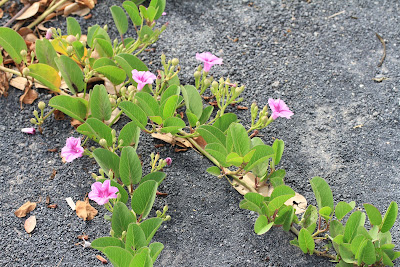
| Common Name | Galápagos Passion Flower |
| Local Name | Vedoca |
| Binomial Name | Passiflora foetida var. galapensis |
| Family | Passifloraceae |
| Notes | Generic name from the Latin passio, inis meaning “passion” and flos, floris meaning a “flower” and referring to the flowers that symbolize the passion and crucifixion of Jesus Christ. [CRC] The specific epithet foetida means bad-smelling; stinking. |
| Status | Native [cdf] |
| Location | Photo 1, 2, 3: Puerto Villamil, Isabela Island near the Hotel Sol. |
Passiflora foetida var. galapensis



| Common Name | Hedgehog Gourd, Teasel Gourd, Tiger’s Egg |
| Local Name | Huevo de Tigre |
| Binomial Name | Cucumis dipsaceus |
| Family | Cucurbitaceae |
| Notes | The generic name has origins in Latin, Akkadian, Greek, and Hebrew. For example, for Latin cucumis and meris mean “cucumber” and “melon”, respectively. The specific eipthet, dipsaceus, means resembling teasel, Dipsacus. |
| Status | Introduced [cdf] |
| Location | Photo 1: Puerto Villamil, Isabela Island. Photo 2: Tortuga Bay Trail, Santa Cruz Island. |
Cucumis dipsaceus (photo 1 left, photo 2 right)


| Common Name | Galápagos Clubleaf |
| Local Name | |
| Binomial Name | Nolana galapagensis |
| Family | Solanaceae or Nolanaceae? |
| Notes | Generic name from the Latin nola meaning small bell referring to the flower or leaf? [CRC] Habitats. |
| Status | Endemic [cdf] |
| Location | Photo 1, 2, 3: Isolete Tintoreras, Puerto Villamil, Isabela Island. |
Nolana galapagensis

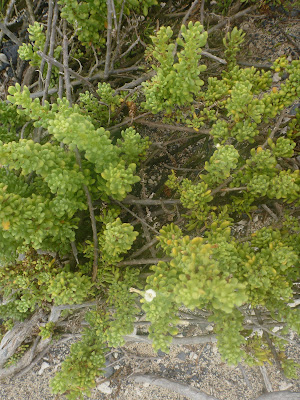

| Common Name | Beach Dropseed |
| Local Name | |
| Binomial Name | Sporobolus virginicus |
| Family | Poaceae |
| Notes | Generic name from the Greek spora, sporos “seed, spore” and ballo, bolis, bolos “casting” and referring to the dropping and dispersion of the seeds. [CRC] For more on Sporobolus see Binomen Art - Sporobolus virginicus. |
| Status | Native [cdf] |
| Location | Photo 1, 2: Puerto Villamil near Hotel Sol. |
Sporobolus virginicus


| Common Name | Button Mangrove |
| Local Name | Mangle Botón |
| Binomial Name | Conocarpus erectus |
| Family | Combretaceae, “deadwood family.” |
| Notes | The generic name, Conocarpus, comes from the Greek konos meaning “cone” and carpos meaning “fruit” referring to the cone-shaped fruit. [CRC] For more on mangroves, see Binomen Art - Mangrove |
| Status | Native [cdf] |
| Location | Photo 1, 2: Puerto Villamil near Hotel Sol. |
Conocarpus erectus


| Common Name | White Mangrove |
| Local Name | Mangle Blanco |
| Binomial Name | Laguncularia racemosa |
| Family | Combretaceae, “deadwood family.” |
| Notes | White Mangrove’s generic name comes from the Latin laguncula meaning “small flask or bottle”. This Laguncularia racemosa fact sheet form the University of Florida states that laguncularia refers the shape of the white mangrove’s fruit and that the specific epithet, racemosa, or “cluster” refers to the growth pattern of the fruits in racemes. For more on mangroves, see Binomen Art - Mangrove |
| Status | Native [cdf] |
| Location | Photo 1, 2: Puerto Villamil near Hotel Sol. |
Laguncularia racemosa
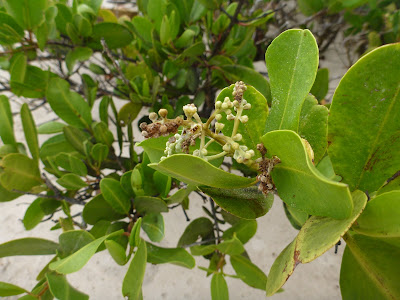
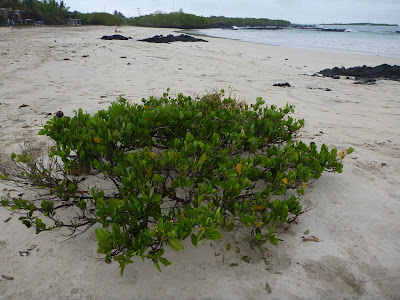
| Common Name | Black Mangrove |
| Local Name | Mangle Negro |
| Binomial Name | Avicennia germinans |
| Family | Acanthaceae |
| Notes | The generic name honors the Persian physician Avicenna (980 - 1037). For more on mangroves, see Binomen Art - Mangrove |
| Status | Native [cdf] |
| Location | Photo 1, 2, 3: Puerto Villamil |
Avicennia germinans
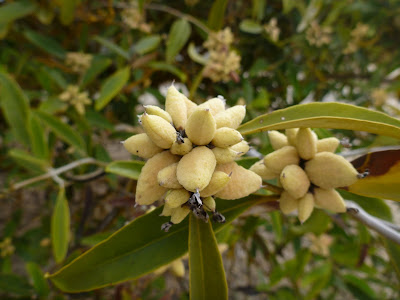
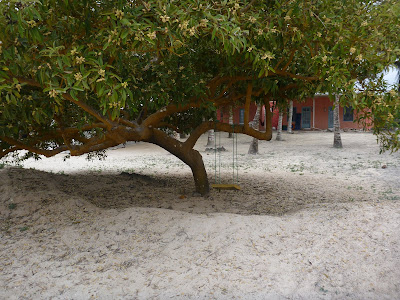

| Common Name | Red Mangrove |
| Local Name | Mangle Rojo |
| Binomial Name | Rhizophora mangle |
| Notes | Generic name from the Greek rhiza “a root” and phoros “bearing, carrying” and referring to the aerial roots. [CRC] For more on mangroves, see Binomen Art - Mangrove. |
| Status | Native [cdf] |
| Location | Photo 1, 2: Puerto Villamil, Isabela Island Photo 3, 4: Playa Ancha, San Cristóbal Island |
Rhizophora mangle Photo 1 and 2


Rhizophora mangle Photo 3 and 4


| Common Name | Inkberry, Sea Grape |
| Local Name | |
| Binomial Name | Scaevola plumieri |
| Family | Goodeniaceae |
| Notes | Generic name for Roman hero C. Mucius Scaevola, whose surname means “left-handed” and referring to the left-hand twisting of the corolla. [CRC] For more, see Binomen Art - Scaevola plumieri. |
| Status | Native [cdf] |
| Location | Photo 1, 2: Road to Wall of Tears, Isabela Island Photo 3, 4: Tortuga Bay, Santa Cruz Island |
Scaevola plumieri (photo 1, 2)


Scaevola plumieri (photo 3, 4)


| Common Name | Gray Mat Plant |
| Local Name | |
| Binomial Name | Tiquilia galapagoa |
| Family | Boraginaceae |
| Notes | Generic name from the native South American name for flower. [ref] Name does not appear in Quattrocchi / CRC. |
| Status | Endemic [cdf] |
| Location | Photo 1: Playa del Amor, Isabela. Photo 2: Playa Ancha, San Cristóbal |
Tiquilia galapagoa (photo 1 left, photo 2 right)


| Common Name | Scalesia Affinis |
| Local Name | lechoso de lava (fern lava), tabaquillo |
| Binomial Name | Scalesia affinis |
| Family | Asteraceae |
| Notes | Interestingly, Scalesia does not appear in Quattrocchi / CRC. For more on the name, see Binomen Art - Scalesia. |
| Status | Endemic [cdf] |
| Location | Photo: Pozzo Redondo, Isabela |
Scalesia affinis

| Common Name | Galápagos Tree Fern |
| Local Name | Helecho arbóreo |
| Binomial Name | Cyathea weatherbyana |
| Family | Cyatheaceae |
| Notes | Generic name from the Greek kyanthos “a cup or ladle”, kaytheion “a little cup,” in reference to the spore cases. [CRC] The specific epithet honors Charles Alfred Weatherby (1875 - 1949), botanist and associated with the American Fern Journal. |
| Status | Endemic [cdf] |
| Location | Photo: Volcan Sierra Negra trailhead |
Cyathea weatherbyana

| Common Name | Wild Cowpea |
| Local Name | |
| Binomial Name | Vigna luteola |
| Family | Fabaceae |
| Notes | Generic name Vigna for Domenico Vigna (d 1647) a 17th century Italian botanist. [dg]. The specific epithet, luteola, is for the yellowish flower. |
| Status | Native [cdf] |
| Location | Photo: Sierra Negra trail, Isabela Island. |
Vigna luteola

| Common Name | Fringed Orchid |
| Local Name | |
| Binomial Name | Habenaria monorrhiza |
| Family | Orchidaceae |
| Notes | Generic name, Habenaria, from the Latin habena meaning rein or strap and referring to the shape of the orchid’s spur. [dg] The lip of this orchid is usually trilobed and always spurred, in some species the spur is long and strap-shaped and swollen towards the apex, or referring to the long anther canals. [CRC] |
| Status | Native [cdf] |
| Location | Photo: Sierra Negra trail, Isabela Island. |
Habenaria monorrhiza

| Common Name | Sacramento Bur |
| Local Name | Pegadillo |
| Binomial Name | Triumfetta semitriloba |
| Family | Tiliaceae |
| Notes | Generic name, Triumfetta, after Giovanni Battista Triumfetti (1658 - 1708) professor of Botany and Director of the Botanical Garden in Rome, Italy. [dg][CRC] The specific epithet, semitriloba, derives from the Greek semi menaning “half” and triloba meaning “three-lobed” referring to the leaves as almost having three lobes? [dg] |
| Status | Native or introduced. [cdf] |
| Location | Photo 1, 2: Sierra Negra trail, Isabela Island. |
Triumfetta semitriloba


| Common Name | Yellow Star-Grass |
| Local Name | |
| Binomial Name | Hypoxis decumbens |
| Family | Hypoxidaceae |
| Notes | The generic name, Hypoxis, from the Greek hypo, (beneath) and oxys, (sharp); referring to the base of the capsule. [ref] The specific epithet, decumbens, means creeping with ends upright. [ref] |
| Status | Native [cdf] |
| Location | Photo: Sierra Negra trail, Isabela Island. |
Hypoxis decumbens

| Common Name | Germander |
| Local Name | Laurel |
| Binomial Name | Teucrium vesicarium |
| Family | Lamiaceae |
| Notes | Generic name possibly for the Greek teukrion for Teucer (Teukros) the founder of the town in Salamis in Cyprus; Latin teucrion for a plant, the germander. [CRC] The specific epithet, vesicarium, mean “with a bladder” - but, referring to what part of the plant? [dg] |
| Status | Native [cdf] |
| Location | Photo 1, 2: Sierra Negra trail, Isabela Island. |
Teucrium vesicarium

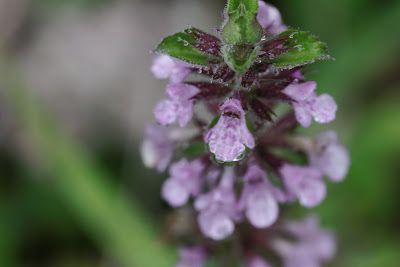
| Common Name | Cat's Claw, Wait-a-Minute-Bush |
| Local Name | Uña de gato |
| Binomial Name | Zanthoxylum fagara |
| Family | Rutaceae |
| Notes | Generic name from the Greek xanthos “yellow” and xylon “wood” referring to the yellow die sometimes contained in the roots of some species. [CRC] |
| Status | Native [cdf] |
| Location | Photo: Los Gemelos, Santa Cruz. |
Zanthoxylum fagara

| Common Name | Lance-leafed Darwin’s Shrub |
| Local Name | |
| Binomial Name | Darwiniothamnus lancifolious |
| Family | Asteraceae |
| Notes | The generic name means “Darwin’s shrub” from the Greek thamnos for bush. The specific epithet, lancifolius, refers to the lance-shaped leaves. |
| Status | Endemic [cdf] |
| Location | Photo: Sierra Negra trail, Isabela Island. |
Darwiniothamnus lancifolious
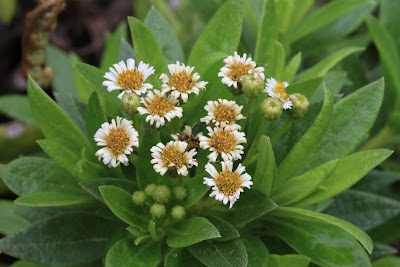
| Common Name | Thin-leafed Darwin Bush |
| Local Name | |
| Binomial Name | Darwiniothamnus tenuifolius |
| Family | Asteraceae |
| Notes | The generic names means “Darwin’s shrub” from the Greek thamnos for bush. The specific epithet, tenuifolius, refers to the slender-shaped leaves. |
| Status | Endemic [cdf] |
| Photo Location | Photo 1: Ranchas Primicias, Santa Cruz Island. Photo 2, 3, 4: Sierra Negra trail, Isabela Island. |
Darwiniothamnus tenuifolius (photo 1 left, photo 2 right)


Darwiniothamnus tenuifolius (photo 3 left, photo 4 right)


Darwiniothamnus tenuifolius (photo 5)

| Common Name | Narrow-leafed Lippia |
| Local Name | Lippia |
| Binomial Name | Lippia rosmarinifolia |
| Family | Verbenaceae |
| Notes | Generic name honors Augusto (Augustin) Lippi, 17th century Italian naturalist. [dg] The specific epithet refers to the foliage resembling rosemary. [dg] |
| Status | Endemic [cdf] |
| Location | Photo 1: Sierra Negra trail, Isabela Island. Near Volcan Chico Photo 2: Muro de las Lagrimas, Isabela Island. |
Lippia rosmarinifolia (photo 1 left, photo 2 right)

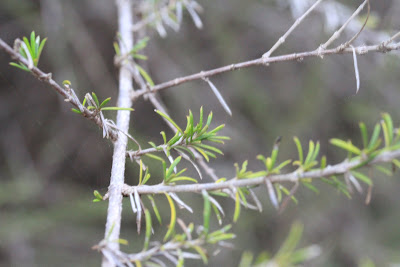
| Common Name | Soapberry, False Dogwood |
| Local Name | El Jaboncillo |
| Binomial Name | Sapindus saponaria |
| Family | Sapindaceae |
| Notes | Generic name from the Latin sapo, saponis meaning “soap” and indicus meaning “Indian, or India”. [ckm] Saponins used as an emulsifier and cleanser. |
| Status | Introduced, escaped [cdf] |
| Location | Photo 1, 2: Sierra Negra trail, Isabela Island. Near Volcan Chico. |
Sapindus saponaria


| Common Name | Scalesia pedunculata |
| Local Name | |
| Binomial Name | Scalesia pedunculata var. pedunculata |
| Family | Asteraceae |
| Notes | For more on the generic name, see Binomen Art - Scalesia. The secific epithet, pedunculata, likely refers to the fact that the flowers are held out on longer peduncles - the stalks that bear the flowers. |
| Status | Endemic [cdf] |
| Location | Photo 1, 2, 3, 4: Los Gemelos, Santa Cruz Island. Photo 5: Ranchas Primicias, Santa Cruz Island. |
Scalesia pedunculata (photo 1, photo 2 – toppled Scalesia)

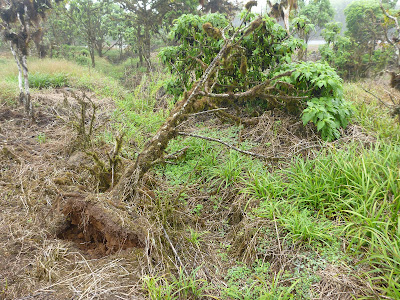 Scalesia pedunculata (photo 3, 4)
Scalesia pedunculata (photo 3, 4)
 Scalesia pedunculata (photo 5)
Scalesia pedunculata (photo 5)
| Common Name | Scalesia cordata |
| Local Name | |
| Binomial Name | Scalesia cordata |
| Family | Asteraceae |
| Notes | For more on the generic name, see Binomen Art - Scalesia. The specific epithet refers to the “heart-shaped” leaves. |
| Status | Endemic [cdf] |
| Location | Photo 1, 2: Campo Duro, Isabela Island. |
Scalesia cordata


| Common Name | Galápagos Peperomia |
| Local Name | Congona |
| Binomial Name | Peperomia galapagensis var. galapagensis |
| Family | Perperomiaceaea |
| Notes | Generic name from the Greek peperi meaning “pepper” and homoios, homios meaning “resembling”. [dg] |
| Status | Endemic [cdf] |
| Location | Photo: Los Gemelos, Santa Cruz Island. |
Peperomia galapagensis var. galapagensis

| Common Name | Galápagos Guava |
| Local Name | Guayabilla |
| Binomial Name | Psidium galapageium var. galapageium |
| Family | Myrtaceae |
| Notes | Generic name from the Latin psidium, from the Greek sidion, from side, sida, sibde or “pomegranate”. [CRC] The specific epithet, galapageium, refers to the fact that this is the endemic guava. |
| Status | Endemic [cdf] |
| Location | Photo: Los Gemelos, Santa Cruz Island. |
Psidium galapageium var. galapageium

| Common Name | Milkberry |
| Local Name | Espuela de Gallo, Chiococca |
| Binomial Name | Chiococca alba |
| Family | Rubiaceae |
| Notes | White berries -> Chion + cocca. |
| Status | Native [cdf] |
| Location | Photo 1, 2: Los Gemelos, Santa Cruz Island. |
Chiococca alba
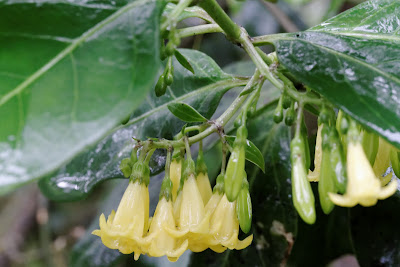

| Common Name | Galápagos Orchid |
| Local Name | |
| Binomial Name | Epidendrum spicatum |
| Family | Orchidaceae |
| Notes | Generic name from the Greek epi “upon, above, on top” and dendron “a tree” referring to the ephiphytic habit of these plants that grow on trees. [CRC] The specific epithet, spicatum, means “grow ears (like corn), in spikes” [dg] - possibly referring to growth habit of the leaves or flower spike. |
| Status | Endemic [cdf] |
| Location | Photo 1, 2: Los Gemelos, Santa Cruz |
Epidendrum spicatum


| Common Name | Chaff flower |
| Local Name | alternantera del este |
| Binomial Name | Alternanthera flavicoma |
| Family | Amaranthacea |
| Notes | Generic name refers to alternating anthers being fertile and sterile, whereas in most species, alternate anthers are barren. [CRC] |
| Status | Endemic [cdf] |
| Location | Photo: Puerto Baquerizo Moreno waterfront, San Cristóbal. |
Alternanthera flavicoma

| Common Name | Indefatigable Passion Flower |
| Local Name | Granadilla silvestre |
| Binomial Name | Passiflora colinvauxii |
| Family | Passifloraceae |
| Notes | Generic name from the Latin passio, inis meaning “passion” and flos, floris meaning a “flower” and referring to the flowers that symbolize the passion and crucifixion of Jesus Christ. [CRC] The specific epithet, colinvauxii, after Paul Colinvaux who discovered the vine. |
| Status | Endemic [cdf] |
| Location | Photo: Los Gemelos, Santa Cruz |
Passiflora colinvauxii

| Common Name | Mormordica, Balsam Pear, Bitter Gourd |
| Local Name | Achojcha China |
| Binomial Name | Momordica charantia |
| Family | Cucurbitaceae - cucumber/melon family |
| Notes | Generic name from the Latin mordeo, momordi, morsum, mordere “to bite” referring to the jagged and chewed appearance of the seeds because the seeds appear if they have been bitten. [CRC] |
| Status | Introduced, escaped [cdf] |
| Location | Photo 1, 2: Rancho Primicias, Santa Cruz |
Momordica charantia
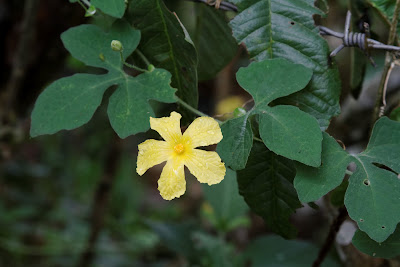

| Common Name | Common Coral Bean |
| Local Name | Porotillo |
| Binomial Name | Erythrina spp. possibly corallodendron |
| Family | Fabaceae |
| Notes | The generic name from the Greek erythros “red” and anthos “flower”. [CRC] |
| Status | Introduced/cultivated [cdf] |
| Location | Photo 1, 2, 3: Rancho Primicias, Santa Cruz |
Erythrina spp.



| Common Name | Spanish Cedar, Cuban Cedar |
| Local Name | Cedrela, cedro cubano |
| Binomial Name | Cedrela odorata |
| Family | Meliaceae |
| Notes | The generic name from the Spanish cedrelo, diminuitive of the Latin cedrus,i “the cedar, Juniperus oxycedrus L. (Plinius)” and Greek kedros “cedar, cedar-tree, prickly cedar, Syrian cedar, Phoenician cedar, Himalayan cedar, juniper”. [CRC] The specific epithet due to the heartwood being aromatic and resembling the aroma of true cedar. |
| Status | Introduced, pest [cdf] |
| Location | Photo 1, 2: Rancho Primicias, Santa Cruz |
Cedrela odorata


| Common Name | Coffee Senna |
| Local Name | Senna Café |
| Binomial Name | Senna occidentalis |
| Family | Fabaceae (Caesalpiniodeae) |
| Notes | The generic name comes from the Arabic sana or sanna. [CRC] |
| Status | Native [cdf] |
| Location | Photo 1, 2: Los Gemelos, Santa Cruz |
Senna occidentalis


| Common Name | Flat-Fruited Senna |
| Local Name | Senna, Caccia-picta |
| Binomial Name | Senna pistaciifolia |
| Family | Fabaceae (Caesalpiniodeae) |
| Notes | The generic name comes from the Arabic sana or sanna. [CRC] |
| Status | Native [cdf] |
| Location | Photo 1, 2, 3: Rancho Primicias, Santa Cruz Island. |
Senna pistaciifolia



| Common Name | Candle Senna |
| Local Name | Palo de Abejón |
| Binomial Name | Senna alata |
| Family | Fabaceae (Caesalpiniodeae) |
| Notes | The generic name comes from the Arabic sana or sanna. [CRC] The specific epithet, alata, means “winged” - possibly referring to dried fruits. |
| Status | Escaped [cdf] |
| Location | Photo: Rancho Primicias, Santa Cruz Island. |
Senna alata

| Common Name | Chaff Flower |
| Local Name | Escansel |
| Binomial Name | Alternanthera mexicana |
| Family | Amaranthaceae |
| Notes | Generic name refers to alternating anthers being fertile and sterile, whereas in most species, alternate anthers are barren. [CRC] |
| Status | Questionable Native [cdf] |
| Location | Photo 1, 2: Sierra Negra Trail, Isabela Island |
Alternanthera mexicana


| Common Name | Common Guava |
| Local Name | Gauyabo, guayaba |
| Binomial Name | Psidium guajava |
| Family | Myrtaceae - the myrtle family. |
| Notes | Generic name from the Latin psidium, from the Greek sidion, from side, sida, sibde or “pomegranate”. [CRC] But why? The specific epithet, guajava, derived from Spanish name for this fruit, guayaba. |
| Status | Introduced, pest [cdf] |
| Location | Photo 1, 2, 3: Rancho Primicias, Santa Cruz |
Psidium guajava



| Common Name | Galápagos Tomato |
| Local Name | Tomatillo |
| Binomial Name | Lycopersicon cheesmanii (ae) Solanum cheesmaniae |
| Family | Solanaceae - Nightshade family. |
| Notes | The generic name Lycopersicon from the Greek lykopersion for an Egyptian plant with a strong-smelling yellowish juice, some suggest from the Greek lykos “a wolf” and persikon “a peach”, possibly referring to the poisonous or toxic properties. [CRC] The generic name Solanum from the Latin solanum, a plant name used probably for Solanum nigrum, solanum applied by Plinius to a plant, also called strychnos, nightshade, from the Latin sol, solis “sun”, the plants of the sun. For other possible origins, see page 2504 of Volume IV. [CRC] The specific epithet, cheesmanii (masculine) was corrected to cheesmaniae (feminine). The person who named this species thought the collector was a man when in fact it was a woman, Lucy Evelyn Cheesman. The story is discussed in the very interesting book, Dry Storeroom #1 by Richard Fortey. |
| Status | Endemic [cdf] |
| Location | Photo: Path to Charles Darwin Research Station, Santa Cruz |
Solanum cheesmaniae
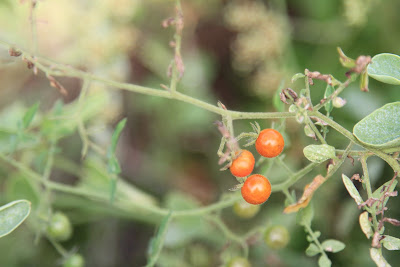
| Common Name | Leatherleaf |
| Local Name | Guide called it arrayán, others say arrayáncillo. Also called Rompe Ollas or “pot-breaker” because it produces a a lot of heat when burned and tends to break clay cooking pots unless used with care. |
| Binomial Name | Maytenus octogona |
| Family | Celastraceae - Staff-tree family. |
| Notes | Generic names from the Chilean (Araucan) maiten, mayten, or mayton for the type species Maytenus boaria. |
| Status | Native [cdf] |
| Location | Photo 1: Path to Charles Darwin Research Station, Santa Cruz Photo 2: Trail to Tortuga Bay, Santa Cruz Island. |
Maytenus octogona (photo 1 left, photo 2 right)


| Common Name | Moon Flower |
| Local Name | |
| Binomial Name | Ipomoea alba |
| Family | Convolvulaceae |
| Notes | Generic name from Greek ips, pios “bindweed, or a kind of worm or beetle that eats vines” and homoios, homios “resembling, similar to,” referring to the habit, or to long trailing stems or to similarities this genus has with Convolvus. [CRC] |
| Status | Questionable Native [cdf] |
| Location | Photo: Sierra Negra Trail, Isabela Island. |
Ipomoea alba

| Common Name | Galápagos Mistletoe, Foradendron |
| Local Name | Suelda con suelda |
| Binomial Name | Phoradendron henslowii |
| Family | Viscaceae |
| Notes | Generic name from the Greek phoros “bearing, carrying,” phero, phoreo “to bear” and dendron “tree. [CRC] P. henslowii is a woody hemi-parasitic shrubs with branches which grows on trees. |
| Status | Endemic [cdf] |
| Location | Photo: Sierra Negra Trail, Isabela Island, Near Volcan Chico. |
Phoradendron henslowii

| Common Name | Needle-Leaf Laricifolia |
| Local Name | Romerillo |
| Binomial Name | Macraea lanricifolia |
| Family | Asteraceae |
| Notes | Generic name from the Greek makros “long”. [CRC]. |
| Status | Endemic [cdf] |
| Location | Photo 1, 2: Sierra Negra Trail, Isabela Island. Near Volcan Chico |
Macraea lacidfolia


| Common Name | Thorn Shrub |
| Local Name | Espino |
| Binomial Name | Scutia spicata (syn. Scutia paucifolia) |
| Family | Rhamnaceae |
| Notes | Generic name from Latin scutum, i “a shield” referring to the form of the disk. [CRC] What part of the plant, the leaves? Species epithet spicata meaning “with spikes”. |
| Status | Questional Endemic [cdf] |
| Location | Photo 1: Trail to Tortuga Bay, Santa Cruz Island. Photo 2: Playa Ancha, San Cristóbal Island. |
Scutia spicata (photo 1 left, photo 2 right)




| Common Name | Brazilian Tea, False Vervain |
| Local Name | Espino |
| Binomial Name | Stachytarpheta cayennensis |
| Family | Verbanaceae |
| Notes | Generic name from the Greek stachys “spike” and tarphys “thick”, tarpheios “dense” referring to the flower spikes and closely packed flowers. Species epithet cayennensis means “of or from Cayenne, French Guinea”. |
| Status | Questional Accidental [cdf] |
| Location | Photo: Sierra Negra trail, Isabela Island. |

Hi....
ReplyDeleteNice site! Galapagos is a great place to travel. I am currently writing an article from our extencive trip to Galapagos in 2011, focusing on Darwin's route here. In this connection I would like to request permission to you your photo of Psidium galapageium show above? The article will appear on this site: www.biophoto.no and full refs and link to your page and photographer will of course be given.
best wishes
Alf J. Nilsen,
Norway
Sure, go ahead. I look forward to reading the article. Please send a link to it when finished. Happy New Year!
ReplyDeleteVery nicely done and quite useful as I am sorting through my photos! Many thanks for your nice work.
ReplyDelete